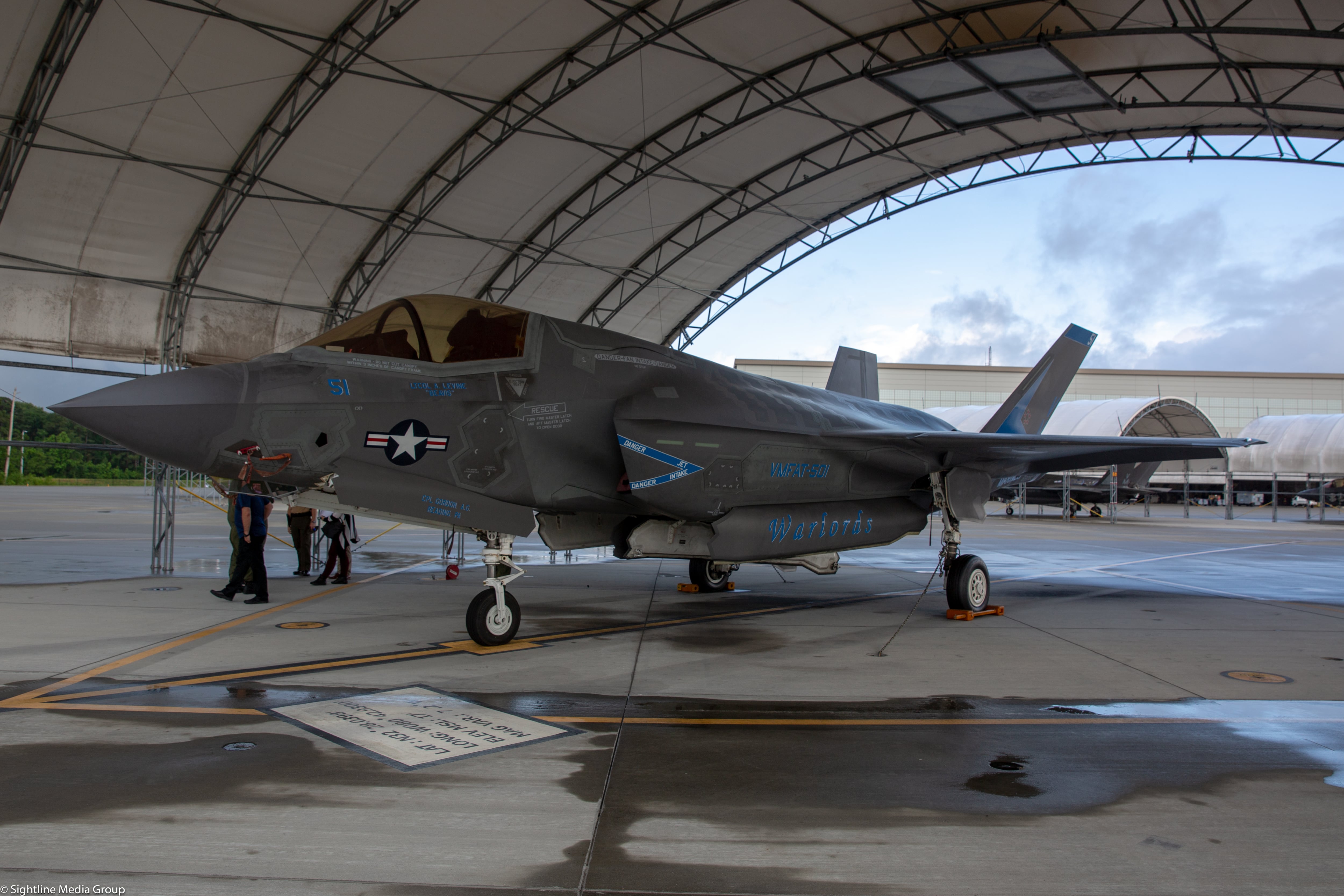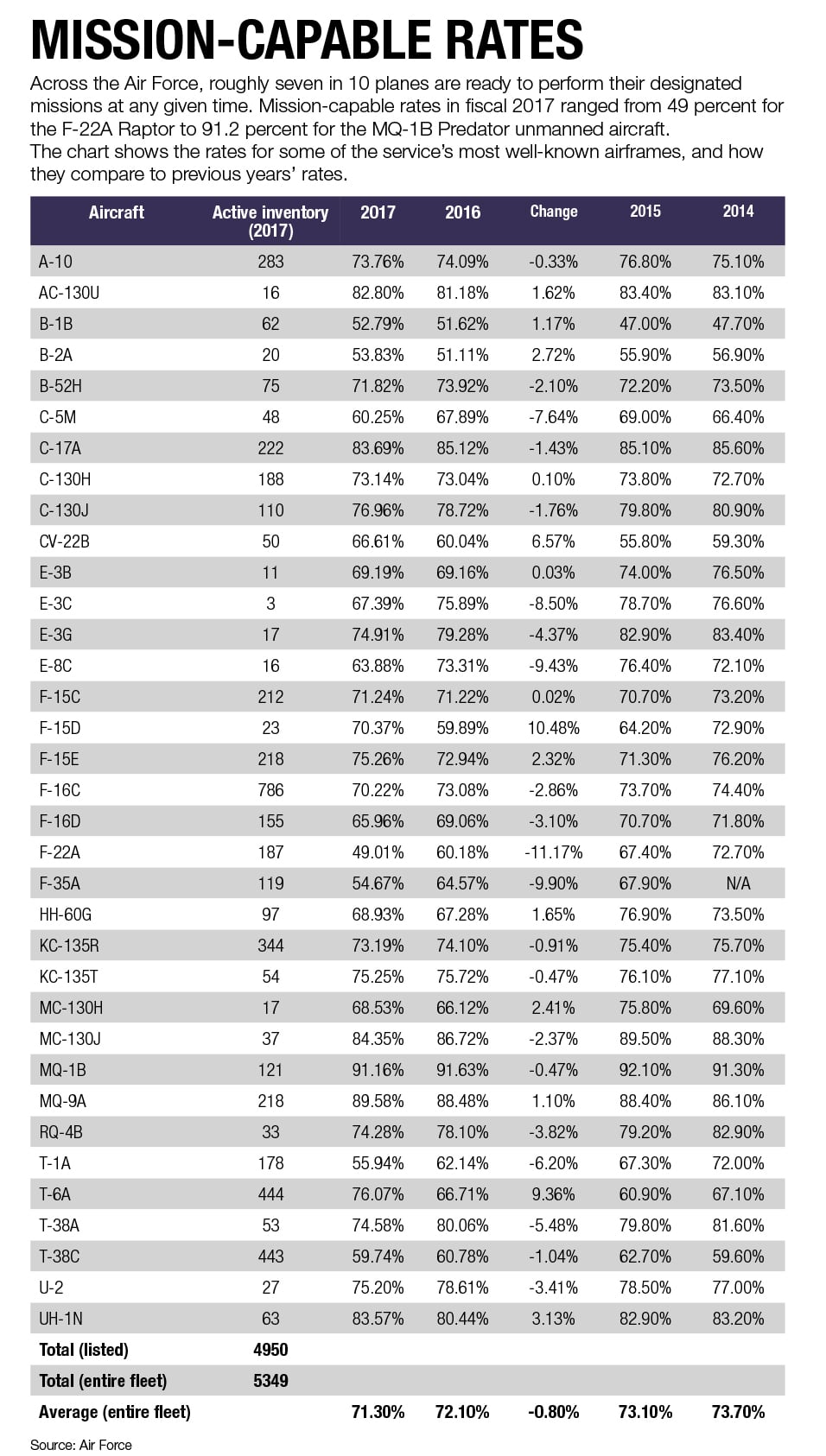WASHINGTON — Secretary of Defense Jim Mattis has ordered the Air Force and Navy to get mission capable rates for four key tactical aircraft up above 80 percent by the end of next September, a daunting challenge given the current readiness rates of America’s fighter fleets.
In a memo issued Sept. 17 to the secretaries of the Army, Air Force and Navy, along with acquisition head Ellen Lord and acting Undersecretary for Personnel and Readiness Stephanie Barna, Mattis acknowledges “budget constraints and shortfalls in aviation squadrons across the force” have led to “systemic underperformance, overcapitalization and unrealized capacity” in the fighter fleets.
“For change to be effective and efficient, we must focus on meeting our most critical priorities first,” Mattis wrote in the memo, obtained exclusively by Defense News.
Specifically, that means achieving a minimum of 80 percent mission capability rates for the Pentagon’s F-35, F-22, F-16 and F-18 inventories — a number well above the mission capability rates those aircraft now achieve. In addition, Mattis wants to see reduced operating and maintenance costs on the platforms, starting in FY19.
The Air Force updates its public readiness figures annually, with the most recent numbers, released in March, covering fiscal year 2017. According to those numbers, 71.3 percent of the Air Force’s aircraft were flyable, or mission-capable, at any given time in FY17. That represented a drop from the 72.1 percent mission-capable rate in FY16, and is part of a bigger picture of decline across the fleet.
Specific to tactical aircraft, the F-16C fleet reported a mission capable rate of 70.22 percent, the just-standing-up F-35A a 54.67 percent mission capable rate, and the F-22 Raptor a shocking 49.01 mission capable rate. While not covered by Mattis’ memo, the F-15C (71.24 percent) and F-15E (75.26 percent) were also below the threshold now sought by the secretary.
RELATED

The Raptor’s rates stand out as the most alarming. When the F-22 was first used in combat towards the end of 2014, its mission capable rate was over 70 percent; as use has increased, its rates have dropped dramatically.
Navy figures are released less regularly, but in an Aug. 7 media roundtable, Navy Secretary Richard Spencer told reporters that the service started 2018 with 241 fully mission capable aircraft, and he said had increased to 270 by the time he met with the press. And almost half of the Navy’s 546 Super Hornets are now mission capable, he said — well below Mattis’ target.
Readiness rates for tactical aircraft aren’t a new issue. A Government Accountability Office report, released last month, tracked readiness rates from 2011 to 2016. The report found that nine of the 12 aircraft surveyed fell short of availability goals, and that overall availability declined for half the planes. Among those surveyed were the F-16, F-22, F/A-18A-D and F/A-18E-F fleets.
“The Air Force and Navy are operating many of their fixed-wing aircraft well beyond their original designed service lives and therefore are confronted with sustainment challenges,” the authors of the report concluded.
Earlier this year, Military Times published an in-depth investigation into year-over-year trends showing an increase in aviation mishaps in the department. The Pentagon has denied there is a “crisis” with aviation maintenance.

Lofty goals?
Hitting that 80 percent readiness minimum within one year of the memo’s issuance may prove a challenge.
Todd Harrison, an analyst with the Center for Strategic and International Studies, said it’s “not impossible” to hit those readiness rates, but warned "it’s going to be difficult to do it and to sustain it."
One trick the services could consider: officially retiring the oldest jets in their fleets, which would lower the overall number of planes while increasing mission ready percentages. However, Harrison notes that only works for the F-16 and F-18 fleets, while putting increased war and tear on the remaining planes that could lead to maintenance issues down the road.
“The other thing to keep in mind is that if you can get the mission availability rate up—and sustain it—then you don’t need as many aircraft,” Harrison said. “For example, a squadron of 20 aircraft with a 60% availability rate is equivalent to a squadron of 15 aircraft with an 80% availability rate. You can effectively grow the force without adding planes.”
For his part, Mattis calls out the commercial aviation industry as a source of inspiration, noting “I am confident in our department’s ability to generate additional capacity from our current aircraft inventory, alongside the commercial aviation industry’s sustainment of high availability rates.
“As we seek to achieve our goals, we can learn from industry’s benchmarks for measuring speed, cost and mission capability, as well as its best practices for implementing a sustainable, Department-wide system.”
And while the memo is limited to just the four key systems, Mattis makes it clear he expects other systems to meet that benchmark eventually, ordering the services to “also set and pursue aggressive targets for other enduring fixed- and rotary-wing aviation assets.”
Notably, Mattis tasks the undersecretary for personnel and readiness to “provide definitions and reporting procedure to measure mission capability and cost.” However, the P&R spot has been open ever since Robert Wilkie was tapped to become secretary at Veterans Affairs. Barna, a career civil servant, is performing the duties of the P&R job.
In addition, Barna, Lord and the service secretaries must “develop and deliver effective implementation frameworks for the F-35, F-22, F-16 and F-18 no later than October 15, 2018,” less than a month from Mattis’ memo being issued. “The frameworks must outline how best practices will be incorporate in units, depots and supply chains.”
The Navy may provide one idea on how to do that. In his August appearance, Spencer highlighted a program called the Depot Readiness Initiative, where he said the Navy is letting the depots perform regular calendar maintenance as well as depot-level maintenance at the same time, a move that cuts out redundant work by performing scheduled and depot maintenance at the same time.
Aaron Mehta was deputy editor and senior Pentagon correspondent for Defense News, covering policy, strategy and acquisition at the highest levels of the Defense Department and its international partners.





